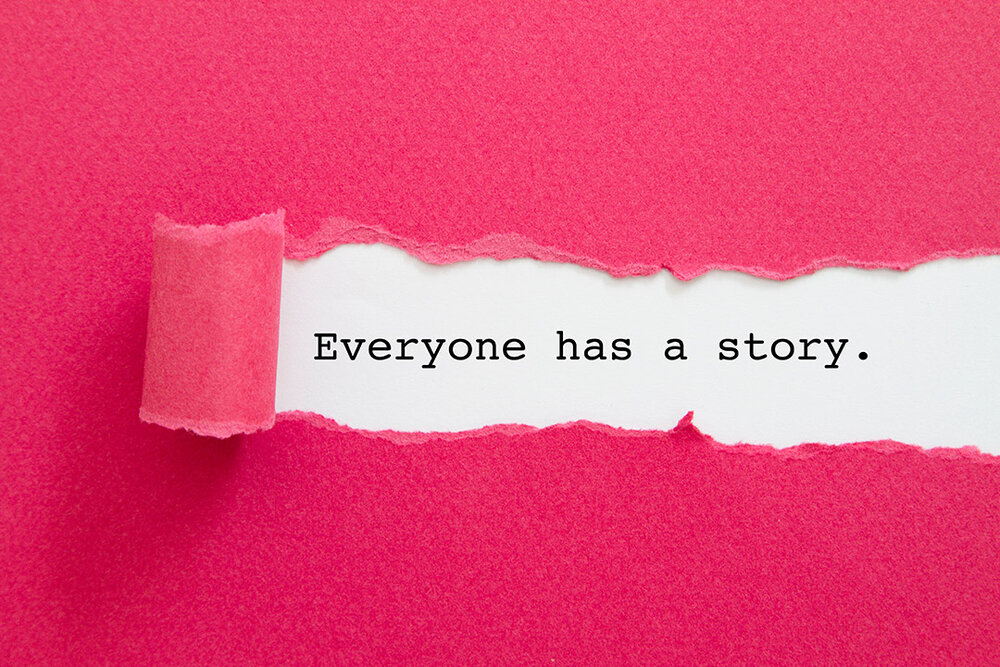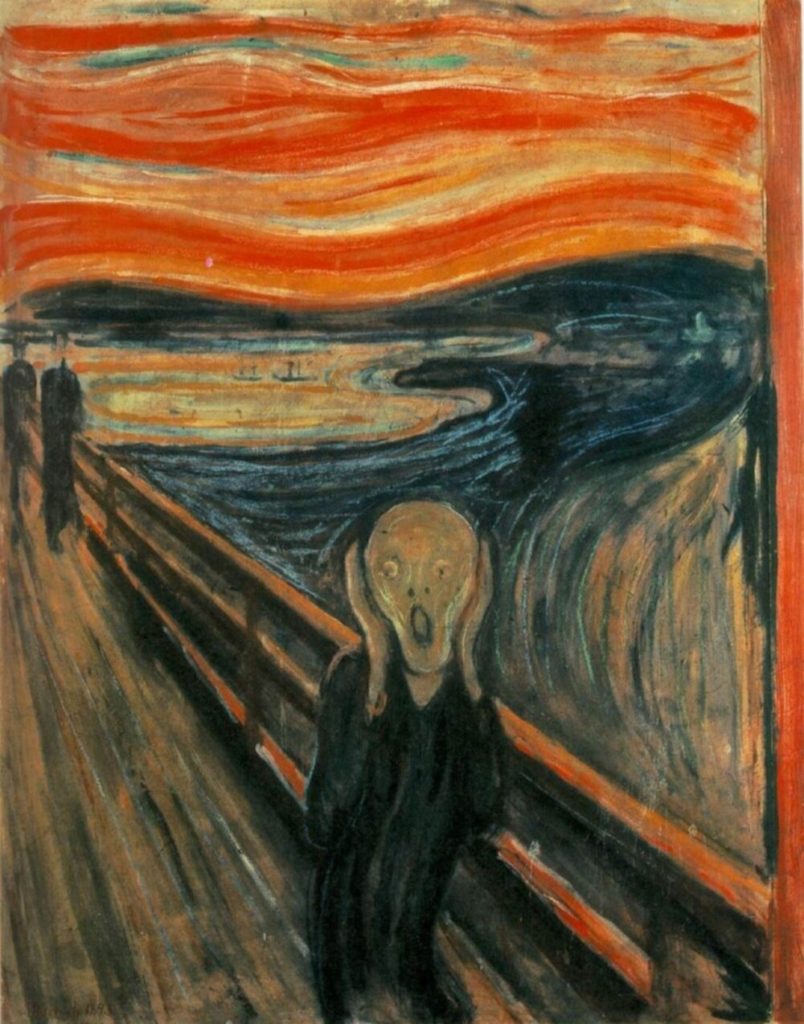Written by Colette Nichol, Story Strategist and Solo Filmmaker
You want to learn how to tell a story, but you’re unsure where to start.
You’ve heard that story structure matters, but what does that even mean? You’re in the right place. We’re going to dig into storytelling in-depth in this article so that by the end, you’ll know exactly how to tell a story and what story to tell.

In This Article:
- Discovering the Power of a Captivating Story
- You Have Stories to Tell
- Why Bother Telling a Story?
- How to Tell a Story
- Main Story Elements
- The Life Before + Answering the Call
- My Top 3 Storytelling Tips
- How to Tell a Story: Two Extra Techniques
- Sales Story Example
- Elements of a Story
- Summary
- If You’re Alive, You Have a Story
Discovering the Power of a Story that Captivates Attention
I discovered the power of story while watching my bleary-eyed ESL students fall asleep in class at 7:30 in the morning.
We were doing a listening activity that I’d accidentally made way too hard for their level. My students look shell-shocked — shoulders slumped, heads drooping like unwatered plants.
As I stood there, pausing to assess the situation, a story popped into my head.
Instead of giving them the usual pep talk and moving onto the next activity, I told them Byron’s story.

Byron was a star student — got 100% on every listening activity and went on to study at an Ivy League school in the US.
But he didn’t start that way. He’d gone from having the worst English comprehension skills to being top of his class. He went from the bottom of the barrel to the number 1 student.
How did he do it?
That hook caught the attention of my students.
They want to know how he’d done it. Within the first 30 seconds of my story, they knew that I was about to tell them something RELEVANT and MEANINGFUL.
They weren’t wrong. As I walked my students through Byron’s struggles, from how he started out to where he ended up, their eyes brightened, they stopped slumping and lifted their heads up. They were activated.
I finished up the story with a takeaway: “Any of you can become the top student in the class. Any of you can double your listening comprehension, just like Byron. All you need to do is take consistent daily action.”
If I’d tried to give them that takeaway without the story, it would have been a total bellyflop.
My students would have rolled their eyes and gone back to sleep.
That’s when it hit me: Story is the KEY to human attention.
I’ve had this takeaway confirmed over and over in the past ten years. Humans dedicate an inordinate number of hours to consuming stories. We listen to stories on podcasts, we watch them on TV and in movies, we read them in books.
We love that one friend who tells amazing dinner-party stories.
The TED Talk Speaker with the fantastic stories is the one who gets 5 million views. Story is arguably as necessary to human existence as air, water, food and shelter.
Without story, our lives lack meaning, and we’re not interested in taking action.
So why should you bother with telling stories? Because it’s the number one way for you to capture attention.

You Have Stories to Tell
Your life is made up of stories.
Not because you’re special. But because everyone’s life is simply a series of stories. If you’ve ever thought to yourself, “Yeah, but I don’t have any great stories to tell,” you’re wrong. But before we go any further, let’s answer this one question: what is a story?
A story is a series of conflicts that end in a takeaway.
Every writer and story strategist has a different definition of the word “story.” (And we’re all a bit pedantic and argumentative about our definitions.)
But no matter what your definition, storytelling, at its core, is a way of communicating the value of human struggle. You strive and strive, overcoming obstacles. Finally, you either win or lose—that win or loss results in a takeaway, which is the only purpose of any story.
Without the takeaway, you don’t have a meaningful story.
Did you catch the keyword there? Meaningful. You can have a story with plenty of conflict, but if you don’t give your audience a takeaway, it lacks meaning. We care about stories because we want to experience the sigh of relief that comes from experiencing lived wisdom. We’re waiting for the takeaway. We know it’s coming, and it had better be there at the end.

Why Bother Telling A Story?
Aside from giving people a dopamine hit, what’s the point of telling a story?
Stories are how we humans like to learn and organize information. We’d prefer to be told a story with a takeaway than be told that we must think or act a certain way.
We’d rather be told a story than given a pile of features and benefits on a sales page.
You can use storytelling in business and political speeches, sales pages, website copy, and emails that actually sell. You can use storytelling at cocktail parties, in the classroom, and anywhere you interact with humans prone to getting distracted or bored.
Now then, let’s tell some stories!
How to Tell a Story

If you want to easily share stories while public speaking or hanging with friends, follow these 12 storytelling tips.
- Open your story with something curious that grabs your audience’s attention.
- Read the room to ensure it’s a good time to share your anecdote.
- Use dialogue to bring the characters to life.
- Pay attention to your audience to see which parts of the story are landing.
- Play with your voice and timing to create drama.
- Don’t be afraid to talk with your hands as you tell your tale.
- Keep the narrative moving forward by focusing on what happens next.
- Share what you or the main character were thinking during key moments.
- Tell a few different people the same story and tweak it each time.
- Watch comedians tell stories and pick up their timing tricks.
- Build your story towards a big dramatic moment.
- Finish with a payoff that gives people a laugh or an aha moment.
How to Tell A Story Well
There are a few basics that every great story must contain. Whether you’re making a short film, writing a sales email, or trying to woo a potential customer, your story needs to have these main story elements:
Main Story Elements
1. Main Character
2. Objective or Desire — What does your character want?
3. Obstacles — What external and internal problems get in the way? What prevents your character from getting what they want?
4. Big Moment of Epic Conflict i.e. a kicker, or the straw that broke the camel’s back. — This might not be necessary for an anecdote, but for a longer story it’s useful. I call this moment the Vader Face-Off because you can see it so clearly in the Star Wars movies where Darth and Luke face-off near the end of the film. This is the big moment of Epic Conflict.
5. Win/Lose Moment — Does your character get what they want? Or do they fail? You can have an up ending or a down ending depending on what you’re trying to demonstrate.
6. Takeaway — What did your character learn from this?
7. Final Transformation — How is your character different now compared to before going through this struggle?
🌟 Related Article: How to Write a Logline that Works
You’d be hard-pressed to tell a half-decent story without these seven elements.
If you take one out, the story won’t be satisfying. Arguably without all these elements, you don’t have a story at all. Instead, you have an Anecdote — the younger, less useful sibling of our great friend, the Story. The longer your story is, the more elements you can include. There’s more to great storytelling than just these seven elements. But if you’re just getting started with telling stories, then start with these.
If your story needs to be longer or you just want to nerd out, you can consider these other story elements:
Additional Story Elements
1. Villain — Is there someone or something that continually blocks your character? Note: the stronger the villain, the more heroic your character appears.
2. Guide — Does somebody help your character take that next step? Does your character meet someone who pushes them towards action?
3. Magical Tools — Does your character use a tool of some kind to tackle their problems? A radio, a sword, a computer, a pogo stick, a bicycle? What do they use to get from A to B?
4. Plan — Does your character share a plan that they’ll use to take action? This is something that’s usually quite clear in adventure movies or action films.
Ex: We need to go to Russia, sneak into the Kremlin, take back the Horrible Weapon, cryogenically freeze Mr. Bad-Boss, and get home to America to bury the Horrible Weapon under the Pentagon.
That’s a heck of a nonsense-action-movie plan.
5. Near-Death Moment — Is there a moment when your character nearly dies either literally or figuratively? They almost give up and quit? They almost throw in the towel?
6. Gatekeepers — Are there people who are blocking the gateway that your character needs to go through? This is a common element in stories. Who are the guards trying to keep your character from going where she needs to go?
🌟 Related Article: What Story Should I Write?
The Life Before & The Call Create Contrast and Capture Attention
There are two final story elements that I consider intensely necessary: the Life Before and The Call.
Not every quickie story contains these, but I think that they should. These elements are inextricably linked.
So here’s how you use these two elements:
The Life Before & The Call
Describe what your character’s Normal Life is like Before they get The Call that changes everything.
The call isn’t necessarily an actual “call.” Though you’ll find it often is. It’s the moment your character gets asked to take action either by themselves or a supporting character or guide. It’s often more powerful to have the call be external.
The character is usually reluctant to answer the call. She doesn’t want to change. She’s not sure if she can go ahead. She’s afraid of failure. But then…something changes inside of her, and she decides to answer the call.
Example of The Life Before/The Call
This is the story of how pure vanity saved my life:
When I was in my early 20s, I fell into an existential depression.
I smoked cigarettes, drank cheap red wine by the cupful, and ate bowls of Cool Whip at 2 in the morning. I hated myself, but I wouldn’t do anything to make a change because I genuinely believed that I might die at any moment, so any action was pointless.
I can remember lying in bed starting up a the ceiling, seeing a gaping void of darkness slowly rolling across my life.
It was like the Edvard Munch Scream painting was taking over my brain.

Then something happened.
But it’s not what you might expect. I got a huge zit. I mean, it was red, angry, and about 1 cm in circumference. It was the King Kong of zits. It sat on my temple, and it refused to disappear. Week after week, it stayed there. Finally, one day as I stood in the bathroom looking at myself in the mirror, and I thought, “I’m going to get rid of this zit, no matter what it takes.”
I immediately got dressed and did what I always did when I needed a solution: I went to the book store.
— That’s the beginning of a longer story about how I ultimately overcame depression.
The Life Before was my meaningless existence. I was experiencing an existential crisis. The Call was this ridiculous zit showing up on my face. It wouldn’t go away, and I was forced to make a decision. I was pushed into action.
The Call provokes a character to take action, despite their reluctance.
If you can include the Life Before and The Call in your story, you’ll give your audience a more satisfying experience. You’ll also be giving them a clear signal that they’re about to hear a story. As you start speaking about the Life-Before moments, your audience knows that they’re about to hear a story. As soon as they hear The Call, they settle in.
They know that there’s going to be a Takeaway, and they commit to hearing your story.
You can get started with your storytelling without going any further, but I have a few more tips.
Is It Worth It?
Need some convincing that doing all the intellectual labour required of storytelling is worth it?
This video will change how you think about story forever. Don’t have 20 minutes to watch a video mid-day?
Save it for later because (for real) this video will convince you that story is your new BFF.
My Top 3 Storytelling Tips
1. Make sure your story is relevant.
Choose a story that’s relevant to the problem your audience is experiencing.
It’s not that you can only tell stories about businesses if you’re writing to business owners. Or that you can only tell stories about acting if your writing to actors. Instead, make sure that the takeaway is relevant to the problems your audience experience. That said, the more your stories are filled with people your audience can relate to the better. You’ll be more likely to help them see what’s possible for them.
2. Make sure your story is meaningful.
There must be a takeaway.
You can’t tell a story that has not essential takeaway. While you’re at it, try to pick stories that you find particularly meaningful. My depression story is meaningful to me. It makes me feel something. It sparks up my soul. When you’re interested and inpsired by a story, it translates better to your audience.
3. Make sure you’ve got enough conflict to power a lengthy story.
You don’t need to tell epic stories.
They can be a few sentences. The longer you go, the more conflict you need. For a simple product page — say you’re selling a lip balm — you can have an ultra short story. It doesn’t need to be pages long.
You can use story for anything.
From an e-commerce product listing to a financial advisor’s website, story will help ideal clients and customers understand why what you sell should matter to them.
Story Example for E-commerce
This is a story example for a $12 lip balm. The point I want to make is that you can use story to sell anything. And you should. Also, the more your product costs relative to other sellers, the better your story must be. If you’re an aspiring novelist reading this, don’t be a snob — the techniques used for selling a lip balm are the same as the one you’d use for writing the next big crime novel.
FROM CRACKED TO KISSABLE LIPS
We made Marigold Gloss because my winter lips were cracking so badly they looked like puzzle pieces.Searching the market for a lip balm that would banish dry winter lips for good, we couldn’t find anything that worked. So we started experimenting and came up with this whipped lip balm made from natural organic ingredients. Marigold Gloss will soothe your lips, heal the cracks, and keep them smooth and plump all winter long. Bonus: it tastes like honey lavender shortbread. —> For lips so delicious, you’d kiss ’em yourself—try Marigold Gloss.
How to Tell A Story: Two Extra Techniques
There are two simple methods that I’ve encountered that are incredibly useful for getting started with storytelling.
One method I learned from Steven Pressfield; the other I learned from Donald Miller.
A Simple Get-It-Done, Trust Your Intuition Method of Writing Stories:
How to Craft Your Story the Steven Pressfield Way
I don’t recall which book he writes about this in, but it’s probably in The War of Art, which you should read anyway.
Here’s the technique:
Simply take a piece of 8.5 x11 paper and draw three lines through it horizontally. This indicates the chunks for the beginning, middle, and end. Write in point form the plot points down on the sheet of paper in the right spot. And make sure you have a plot point that transitions the story from Act 1 to Act 2, and from Act 2 to Act 3.
There’s always at least 3 big shifts in the action that change the circumstance irreversibly.
The first significant shift takes us from Act 1, and moves us into Act 2. The next big shift brings us into Act 3. And the final big shift is the climax which brings us towards the resolution and the end of the story.
If you’re writing a sizeable story, it will help to consciously break it into three acts. This allows you to make sure nothing is missing.

A Strategic Sales Page + Ted-Talk Storytelling Framework:
How to Craft Your Story the Dennis Miller Way
This method is for business owners, specifically. But it will also work in Ted-Talk style speeches, email storytelling and short product pages. While there are over 10 elements of a story, you can simplify story structure in the following way.
In his book StoryBrand, Miller breaks a story down into these elements:
1. A Character Wants something…
2. …but has a High Stakes Problem (Internal, External, and Philosophical).
3. A Guide with Empathy and Authority…
4. Gives her a Simple Plan…
5. Which she takes Action on…
6. Because she wants to Succeed…
7. Rather than Fail…
8. Which results in Transformation.
If you were to just use this simple structure in creating all your sales emails or product pages, you’d be able to harness the power of story and boost your sales.
To prevent this article from getting too long, let me simply say that if you haven’t read StoryBrand by Dennis Miller, today is the day to buy it. If you’re building a new website, his other business book Marketing Made Simple is also a good read.
Now let’s dig into an example of how you could use this framework.
Sales Story Example:
USE CASE FOR STORY:
Let’s say that I’m the Admissions Director of a private school. A parent is touring the school with me. They ask me if we’ve been able to successfully help students who were struggling. Here’s the true story I tell them.
SALES STORY:
A few years ago, two parents (SUPPORTING CHARACTERS) came to us desperate and fed up with the public school system. Their daughter (MAIN CHARACTER) wasn’t doing well in school even though she worked incredibly hard. She studied and did her homework, but her results were mediocre at best. (PROBLEM)
Her parents had immigrated to Canada and had worked hard to be successful. They worried their daughter wouldn’t get into a good university with her grades hovering in the C+ range. Their hard work would have been for nothing. (STAKES) Luckily, both parents liked our school, and so did their daughter. They had considered one of the bigger, more prestigious private schools, but they worried she would get lost in such a large school.
We told that family to enrol her at our school because we knew we could help. (GUIDE + PLAN) So they applied, and their daughter started with us in Grade 5. (ACTION)
Over the next few years, this young girl’s academic performance improved. Because she received one-on-one attention from our teachers, we could see where she was struggling and help her improve. (SUCCESS)
This year she graduated and was elected valedictorian. She was one of the top students in the school. She’s going to school in England and is planning on becoming a lawyer. (SUCCESS) But if she hadn’t switched schools, she may have struggled all the way through to high school and graduated with low grades and low self-esteem. (FAILURE) Instead, she’s a confident and articulate young woman. (TRANSFORMATION)
BETTER THAN A SALES PITCH
Can you see how a story like this would be powerful during a sales conversation? It’s much more persuasive than saying, “Yes, we have a track record of helping students who were hard workers but still struggling.”
A story takes people on an emotional journey where they start rooting for the main character.
As they root for the main character, they begin to empathize and put themselves in that character’s shoes. They begin to feel the elements of the story. They feel the success, and they feel the potential for failure. This helps them justify using their hard-earned resources (i.e. money) to make a big (or small) purchase.
A story works just a well in the art of ideological persuasion.
This is why you need to watch out for repetitive stories in the media. You know if you see the same story repeatedly that you’re being manipulated. But if you’re writing a speech, using stories like this will be critical. Nobody will care about your data or your discoveries if you don’t wrap them up in a story envelope.
You’ve got to package your discoveries and ideas so that people can understand their value and make sense of them. The only way to do that is to use storytelling.

Elements Of A Story
When you’re trying to tell a captivating story, it helps to understand the elements of a story.
Some of the core elements of a story are as follows:
- a complex main character
- transformation
- desire or objective
- obstacles
- tension
- imagery
- emotion
- hook
- takeaway or treasure
- structure
- theme
- plot
- tone
- style
- setting.
Learning more about the basic elements of a story isn’t complicated. It doesn’t take years to learn, but you will need to spend a few hours per week digging into different stories and pulling them apart. One of the best things you can do to get better at storytelling is to watch movies and analyze their story elements.
As your next step, I recommend reading one of my most popular blog posts, which covers the top 10 elements of a good story.
Summary
- You can use stories to sell anything. You can also use them to capture anyone’s attention.
- Make sure your stories are relevant and meaningful to your audience.
- A story can be used to persuade and convince without the audience feeling like they’re being persuaded or convinced.
- A story must have a main character with a big desire and a conflict.
- If there’s no conflict, you don’t have a story.
- If you want to super-charge your story add these two things: The Life Before and The Call.
- Struggling with your storytelling: create the structure first on a sheet of paper drawing out the beginning, middle, and end. The more you focus on structure first, the less pain you’ll feel when writing.
If You’re Alive, You Have a Story
No matter how boring you think your life has been, you’ve actually been inadvertently living one story after another.
Our lives are organized and made meaningful by the stories we live. If you’re alive, you’ve got stories.
So what story can you use in your next email, or sales page, or business meeting or speech?
- Start with the takeaway you want your audience to receive.
- What do they need to learn or feel?
- Then search your mind for a story that could give them that takeaway.
Here’s a hint: you can take almost any story and tweak it to give the desired takeaway.
So don’t spend hours trying to figure out the perfect story. Just think of a couple options and pick the story that you think will be the most meaningful to your audience.
After all, a story isn’t just meant to be told, it’s meant to be heard.
Learn Filmmaking and Get the Gear Guide
If you’re interested in learning filmmaking, check out the Solo Filmmaking Mentorship Program I created for aspiring filmmakers and video creators. It usually goes live once per year. So I recommend getting the Story Envelope Filmmaking letter which comes out a couple of times per month. That way, you can get filmmaking tips for free and find out when the filmmaking course is going live again.
Also, before you go, grab the Solo Filmmaking Gear Guide and Checklist for Beginners.

About the Author
Hi! I’m Colette Nichol. I’m a solo filmmaker and story strategist based out of rainy Vancouver, Canada. I’ve been making videos and micro films for small businesses and global brands since 2014.
Plus, I LOVE to help aspiring filmmakers pursue their dreams and start making films. This blog is designed to help you gain the knowledge you need to become a filmmaker.
If you want more, get on the waitlist for the Story Envelope Academy Solo Filmmaking Mentorship Program. It opens up one time per year and is the best way to become a filmmaking or video pro fast!
CLICK HERE to get on the solo filmmaking mentorship waitlist.
More Story Articles
🌟 How to Tell a Captivating Story
🌟 How to Overcome a Creative Block When Nothing Else Has Worked